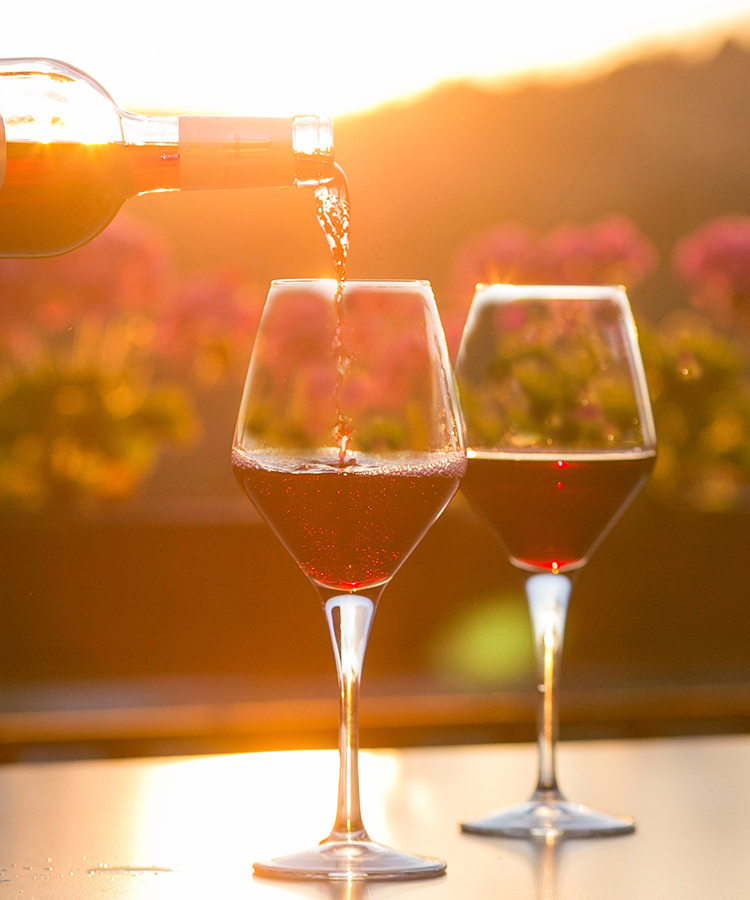During a recent trip to Munich, I took a brief respite from the many liters of beer I’d been consuming to order a glass of German wine as a nightcap. My family was shocked when the glass that arrived was not white, but red. “They make red wine in Germany?” they asked, puzzled. “Is it any good?”
It’s true. German winemakers do produce red wine, and yes, it’s quite good. The quality is actually rising with each vintage. Red grapes now account for over a third of vineyard plantings in Germany, which might surprise those who automatically associate the country with its signature Riesling grape. That doesn’t mean that red wine is new to Germany, however. Some red grapes were documented in the country as far back as the 14th century. But whereas red German wine was historically a sweet wine, and more recently thought to be pale, thin, and acidic, today German reds can be complex, long-aging, and downright intense.
While most of Germany’s regions have classically cool climates, rising world temperatures and careful, sun-drenched site selection now allow red grapes to fully ripen. Enthusiastic young winemakers and increased interest in varietal German reds like Spätburgunder, Dornfelder, and Portugieser are making these once-rare wines increasingly available outside Germany.
There’s no doubt that it is physically possible to produce high-quality red wine in Germany, as the Germans themselves well know. But when red grapes need to compete for top vineyard sites with prized grapes like Riesling, they have to put up a tough fight. As praise and demand for German reds grow internationally, however, we’re betting on seeing more of Germany’s top red varietals stateside.
Spätburgunder (Pinot Noir)
Germany’s most heralded red grape is one of the most popular worldwide: Pinot Noir, or Spätburgunder, as it’s known locally. In fact, Germany is the globe’s third-largest producer of Pinot Noir after France and the United States. While Spätburgunder is found in several of Germany’s regions, it is most closely associated with the warm, southerly Baden area, located just across the border from Alsace in France.
Baden Spätburgunder is generally full-bodied, but soils and winemaking styles vary throughout the region, creating wines that can range from intensely earthy to approachably fruity, long-aging to everyday, and heavily oaked to lithely restrained. Other top regions for Spätburgunder include the Pfalz, the Rheinhessen, the Mosel Valley, and the Rheingau, particularly the west-facing slopes in the village of Assmanhausen.
Dornfelder
Unlike some offbeat varieties, it’s simple to trace the origin of the Dornfelder, Germany’s second-most-popular red grape. Dornfelder was purposefully created in 1955 by a German grape breeder to add color to the country’s classically pale red wines. Perhaps because it was designed to be a blending grape, varietal Dornfelder wines are still uncommon, though producers feel the grape has great potential. Everyday Dornfelder wines from areas like the Pfalz and the Rheinhessen tend to be fresh and fruity, with a slightly floral quality, while top versions can gain complexity, richness, and spice from barrel aging.
Portugieser
Though its name might suggest otherwise, Portugieser came to Germany by way of Austria, where it is still planted today. Known for making pale, medium-bodied wines with mild acidity that doesn’t suit well for long aging, Portugieser ranks eighth in terms of vineyard holding in the country. However, in regions like the Pfalz and the Ahr, the grape can produce a friendly, easygoing red with fresh berry and pepper aromas, or is classically used in traditional German rosé.
Other Red Grapes
Other red grape varieties are found in Germany’s vineyards in small numbers; and, unfortunately, few bottles are exported. The light, fresh Trollinger is better known as Schiava in northern Italy’s Alto Adige region, and Württemberg’s concentration of Schwarzriesling and Lemberger grapes are far more famous as Champagne’s Pinot Meunier and Austria’s Blaufränkisch, respectively.
Five German Reds to Try
Weingut Bernhard Huber ‘Alte Reben’ Spätburgunder 2014, Baden
Widely considered to be the father of modern Baden winemaking, the late Huber and now his son are known for crafting complex, Burgundian Pinot Noirs.
Salwey Spätburgunder Trocken 2014, Baden
Fragrant and elegant, this estate Pinot Noir is an incredible value for its complexity.
Shelter Winery ‘Lovely Lily’ Pinot Noir 2015, Baden
This bottle is as friendly and juicy as Shelter’s current winery dog, Ira, who happily greets visitors.
August Kesseler Spätburgunder 2014, Rheingau
One of the most famous producers of Rheingau Spätburgunder, Kesseler makes wines with great structure.
Gerd Anselmann Dornfelder 2015, Pfalz
One of the few dry Dornfelder wines available stateside, this bottle is medium-bodied, juicy and easy-drinking,
